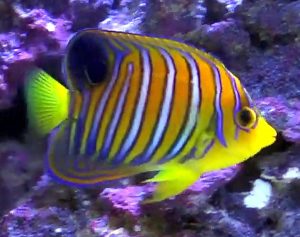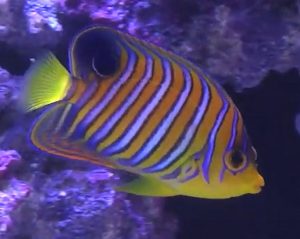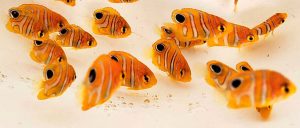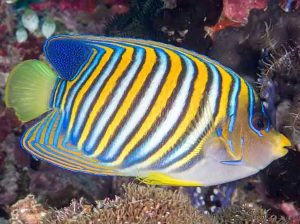The Regal Angelfish (Pygoplites diacanthus) known to tropical fish keeping enthusiasts as the Royal Angelfish is widely distributed throughout the Indo Pacific and is collected from the Red Sea and Indian Ocean around East Africa and the Maldives, to the Tuamoto Islands, New Caledonia, and in northern Australia, the Great Barrier Reef. It’s northernmost range ends in the southern area of the East China Sea around Taiwan and the Ryukyu and Ogasawara Islands of Japan.
Regal Angelfish can be found in protected shallow inner reefs, lagoons, bays, and outer reef slopes of their range at depths exceeding 260 feet, where they are frequently seen alone, in pairs, or smaller groups feeding on sponges and tunicates that are located in the reefs and underwater caves.
Juvenile Regal Angelfish are an extremely shy, secretive species that are frequently found sheltering under rocky ledges, in crevices, and swimming upside down on cave ceilings.
Regal Angelfish fish have a bright yellow body color with alternating backward angled white and orange vertical stripes that are outlined in royal blue. The rear portion of the dorsal fin is dark blue or black with closely set blue dots and the rear portion of the anal fin has alternating yellow and blue bands running parallel to the contour of the body. The caudal fin is a bright yellow color.
There are no external differences between males and females.
Juvenile Regal Angelfish are a bright copperish yellow color with white vertical stripes outlined in dark blue with a large, bright, dark spot outlined in white on the rear portion of the soft dorsal fin.
Although regional color differences of Regal Angelfish occur in the Red Sea, Indian Ocean, and South Pacific Oceans, the general description given above remains constant.
Regal Angelfish can be housed in a peaceful community aquarium with plenty of hiding places or in a reef environment however, large angelfish, triggerfish, puffers, surgeonfish, and overly aggressive clownfish should be avoided.
Tropical fish keeping enthusiasts find Regal Angelfish one of the most popular species however, they are difficult to acclimate and feed, especially in a community environment. It is important that they are introduced into the system first so they can establish their own territory and give them the best opportunity of survival. Juveniles are peaceful but large adults are considered to be semi aggressive. Adults will usually get along well with dwarf angelfish but are territorial with other larger angelfish species.
Adult Regal Angelfish do best in a mature reef aquarium of at least 125 gallons with plenty of live rock arranged into caves, overhangs, and crevices for them to hide among. They do best with SPS corals and other unpalatable coral species and although Regal Angelfish collected in the wild may nip at LPS corals, soft corals, and clam mantles; they will generally ignore ornamental inverts and corals.
Although commercially bred for the aquarium trade, as of this date no successful breeding of Regal Angelfish in an aquarium environment has been reported.
Like other angelfish species, Pygoplites diacanthus lay pelagic eggs and has pelagic larvae. The spawning ritual occurs at dusk or at night where a spiraling dance is performed before the eggs and sperm are released into the water column. After spawning, the eggs are left to float in the water column.
In their natural environment, Regal Angelfish are primarily carnivores that feed on sponges and tunicates. In an aquarium environment, they should be fed a varied diet of meaty foods including raw shrimp, squid, clams, mussels, krill, and occasionally some type of herbivore diet that includes spirulina and sponges. Pygoplites diacanthus are notoriously difficult to feed and require patience with a wide range of fresh and frozen foods to jump start their appetite.
A healthy specimen housed in the right environment will usually begin feeding within days when offered a variety of live, frozen, and flake or freeze-dried foods however, a hostile aquarium environment will directly counter your acclimation and feeding efforts.
Once they begin feeding, many tropical fish keeping enthusiasts offer Regal Angelfish a high quality marine carnivore pellet, frozen Mysis, Spirulina
, frozen brine shrimp, and a frozen sponge fortified angelfish formula, which usually maintains their attention.
Regal Angelfish (Pygoplites diacanthus) are not common in the aquarium trade but are available to tropical fish keeping enthusiasts from a variety of sources online and from local tropical fish shops. Commercially raised specimens are periodically available from farms at prices from $169.99 for a 2.5 ” Indo Pacific Juvenile to $249.99 for a 3-4″ specimen. Larger adult specimens can run over $400.00.
Minimum Tank Size: 125 gal
Aquarium Type: Reef compatible
Care Level: Very Difficult
Temperament: Semi Aggressive
Aquarium Hardiness: Hardy when acclimated
Water Conditions: pH 8.1-8.4, 72° to 80°F, dKH 8 – 12°, SG 1.020-1.025
Max. Size: 10″
Color Form: Yellow, Blue, White
Diet: Omnivore
Compatibility: Peaceful Community
Origin: Indo-Pacific Ocean
Family: Pomacanthidae
Lifespan: 15 years
Aquarist Experience Level: Expert ONLY






4rbr2lc
We research each species before we make any post. There is a lot of inaccurate information on the internet as well as what is given out by shop operators that often misidentify species and provides the wrong parameters for keeping each species. This site is educational, instructional, and does not make any money. If AI can do what we do, I would be more than interested in using it.
John Neila